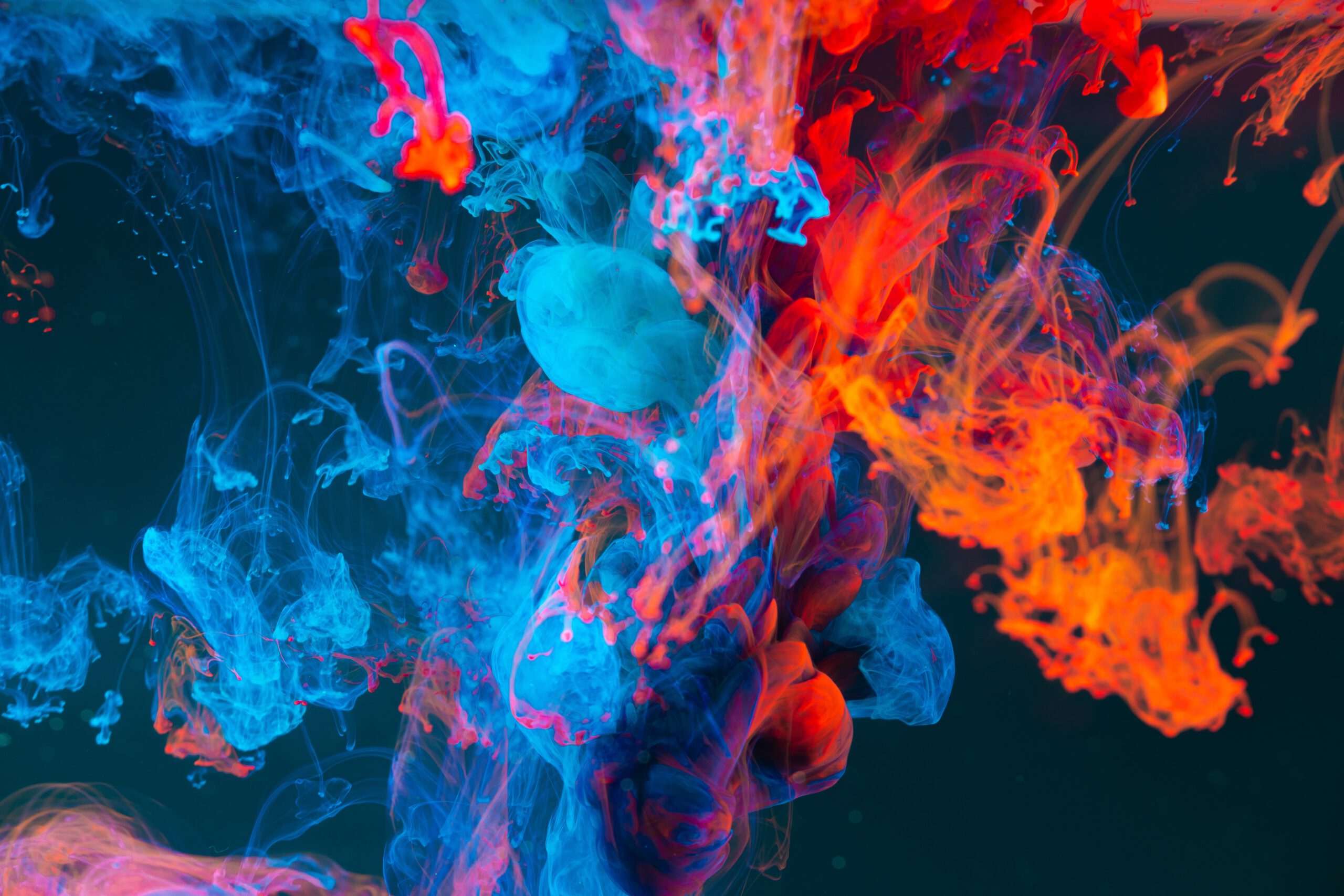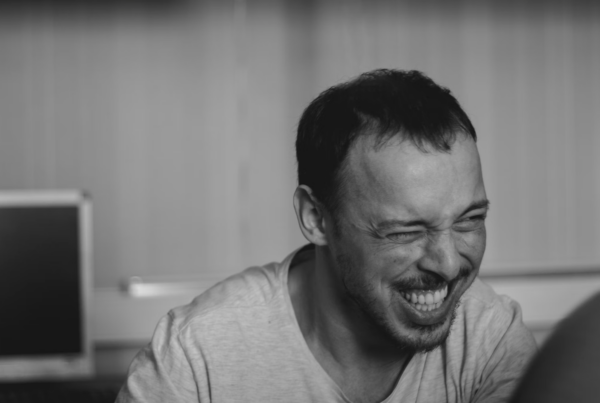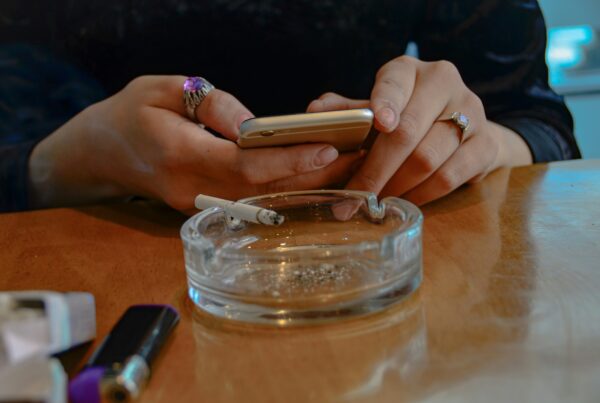
Synesthesia is a phenomenon in which some stimuli simultaneously evoke several senses. The cause might be found in excessive neural connections between some brain areas. Some synesthetes express their experiences through music and art.
Synesthesia is a phenomenon in which some stimuli simultaneously evoke several senses. The cause might be found in excessive neural connections between some brain areas. Some synesthetes express their experiences through music and art.

Photo by Lucas Benjamin on Unsplash

Photo by Lucas Benjamin on Unsplash
For most of us, perception is quite straightforward. We hear sounds, see colors and shapes, and smell odors all one at a time. However, this way of perceiving our surroundings is not the same for everyone. About 2% of the population has a form of synesthesia (Simner et al., 2006), which means they experience the automatic activation of additional sensory pathways when one pathway is activated (Ward, 2013). In other words, some of the stimuli they perceive, also called inducers, consistently evoke several other senses as well. This could for example result in associating letters and numbers with colors, which is known as grapheme-color synesthesia. Other forms are chromesthesia, which means experiencing colors when hearing different sounds, or taste-shape synesthesia which describes people who link taste to geometric shapes. This article will review some ways to assess synesthesia, possible underlying neural mechanisms, and finally, how synesthesia might link to creativity.
The most defining way in which synesthetes differ from non-synesthetes is the consistency of their experiences. It turns out that even though different synesthetes may have different associations between senses, for any given individual a formed association remains unchanged over extended time spans. As an illustration, consider the case of J.I.W., who managed to name the same gustatory experiences induced by different words when tested 27 years after his first report of those associations (Simner & Logie, 2008). People without synesthesia tend to forget any learned association between stimuli after much shorter time intervals, typically tested after only a week, even when they are highly motivated to remember and generate the associations themselves. Synesthetes, on the other hand, do not simply forget or change their synesthetic associations (Simner & Hubbard, 2013).
“attention to the inducer seems to be vital for synesthetic experiences to arise”
Nonetheless, attention to the inducer seems to be vital for synesthetic experiences to arise. To demonstrate this, Sagiv et al. (2006) administered a visual search task. The target of this search task was a specific letter or digit amongst an array of letters. Whilst all letters, including the target, were printed in grey, test subjects with synesthesia had previously reported the target letter as an inducer and for example, associated the color blue with the target letter. If synesthesia would occur preattentive, one would expect synesthetes to outperform controls on this search task and, as a result of a pop-out effect, find the target letter significantly faster. However, this was not the case. This suggests that the neural mechanisms of synesthesia operate on later processing stages, specifically in the parietal lobe and secondary processing areas such as color areas V4 and V8 (Sagiv et al., 2006). The neural explanation of synesthesia might be found in excessive neural connections in some areas, possibly because of decreased neural pruning during infancy (Ramachandran & Hubbard, 2001).
Taking a look at how synesthesia influences the daily life of those affected, the condition is by no means seen as maladaptive. A link between synesthesia and creativity has long been suspected and indeed, synesthetes tend to spend more time in creative arts than the general population (Ward et al., 2008). Some studies have also suggested that the prevalence of synesthesia among art students is especially high: estimates range from 7% (Rothen, 2010) up to 23% (Domino, 1989), compared to the abovementioned 2% in the general population. The exact mechanism of how synesthesia relates to creativity is far from understood, however, there are some intriguing suggestions. Ramachandran et al. (2001) introduce the idea that the above-mentioned excessive neural connections in the synesthete brain not only account for coactivating senses but also help synesthetes to come up with creative metaphors and ingenious language use by facilitating the linkage of seemingly unrelated concepts and words. This might happen because of increased neural connections in additional brain areas than those related to processing senses. However, more research is needed to support this. Moreover, synesthetes who see colors in response to sounds or letters might benefit from extensive experience with those colors. The ever-present experience of color induced by other stimuli possibly enhances sensitivity to all forms of color. Some synesthetes, for example, are better at discriminating between very similar colors (Brang, 2011). Maybe it is this pervasiveness of color that accounts for some of the high numbers of synesthetes found in arts.
“Franz Liszt used the colors he saw in response to sound to guide his orchestral compositions”
In fact, there are quite a number of synesthetes who report using their multisensory experiences as a way of creating art and music. Dating back to the 19th century, expressions of synesthetic experiences can be found in the art of famous painter Kandinsky. Kandinsky used the colors he saw when listening to music as inspiration for many of his abstract paintings and subsequently, he even gave them musical titles, such as Composition and Improvisation (Miller, 2014). But Kandinsky is not the only one. Franz Liszt used the colors he saw in response to sound to guide his orchestral compositions and direct just the right pitch to each instrumentalist (Elise, 2016). There are also contemporary artists with synesthesia: the well-known musician Pharrell Williams explained that he combines sounds by matching the colors they evoke, and singer Charli XCX stated that the colors she sees when listening to music determine if she likes a song (Elise, 2016).
Maybe synesthesia is linked to creativity because synesthetes like the ones just mentioned, can come up with ingenious ways to express their experiences or make use of them to create music and art. Still, much remains to be discovered about how the neural mechanisms of synesthesia might account for links to creativity, how they operate in general, and how synesthesia comes about. <<
References
– Brang, D., & Ramachandran, V. S. (2011). Survival of the synesthesia gene: Why do people hear colors and taste words?. PLoS Biol, 9(11), e1001205.
– Domino, G. (1989). Synesthesia and creativity in fine arts students: An empirical look. Creativity research journal, 2(1-2), 17-29.
– Elise K., (2016, November 10), 12 Famous Artists with Synesthesia, https://www.mentalfloss.com/article/88417/12-famous-artists-synesthesia
– Miller B., (2014, March 19), Wassily Kandinsky’s Symphony of Colors, Denver Art Museum, https://www.denverartmuseum.org/en/blog/wassily-kandinskys-symphony-colors
– Ward, J., Thompson‐Lake, D., Ely, R., & Kaminski, F. (2008). Synaesthesia, creativity and art: What is the link?. British Journal of Psychology, 99(1), 127-141.
– Ramachandran, V., & Hubbard, E. (2001). Psychophysical Investigations into the Neural Basis of Synaesthesia. Proceedings: Biological Sciences, 268(1470), 979-983.
– Ramachandran, V. S., & Hubbard, E. M. (2001). Synaesthesia–a window into perception, thought and language. Journal of consciousness studies, 8(12), 3-34.
– Rothen, N., & Meier, B. (2010). Higher prevalence of synaesthesia in art students. Perception, 39(5), 718-720.
– Sagiv, N., Heer, J., & Robertson, L. (2006). Does binding of synesthetic color to the evoking grapheme require attention? Cortex, 42(2), 232-242.
– Simner, J., Mulvenna, C., Sagiv, N., Tsakanikos, E., Witherby, S. A., Fraser, C., … & Ward, J. (2006). Synaesthesia: The prevalence of atypical cross-modal experiences. Perception, 35(8), 1024-1033.
– Simner, J., & Logie, R. H. (2008). Synaesthetic consistency spans decades in a lexical–gustatory synesthete. Neurocase, 13(5-6), 358-365.
– Simner, J., & Hubbard, E. M. (Eds.). (2013). Oxford handbook of synesthesia. Oxford University Press.
– Ward, J. (2013). Synesthesia. Annual review of psychology, 64, 49-75
For most of us, perception is quite straightforward. We hear sounds, see colors and shapes, and smell odors all one at a time. However, this way of perceiving our surroundings is not the same for everyone. About 2% of the population has a form of synesthesia (Simner et al., 2006), which means they experience the automatic activation of additional sensory pathways when one pathway is activated (Ward, 2013). In other words, some of the stimuli they perceive, also called inducers, consistently evoke several other senses as well. This could for example result in associating letters and numbers with colors, which is known as grapheme-color synesthesia. Other forms are chromesthesia, which means experiencing colors when hearing different sounds, or taste-shape synesthesia which describes people who link taste to geometric shapes. This article will review some ways to assess synesthesia, possible underlying neural mechanisms, and finally, how synesthesia might link to creativity.
The most defining way in which synesthetes differ from non-synesthetes is the consistency of their experiences. It turns out that even though different synesthetes may have different associations between senses, for any given individual a formed association remains unchanged over extended time spans. As an illustration, consider the case of J.I.W., who managed to name the same gustatory experiences induced by different words when tested 27 years after his first report of those associations (Simner & Logie, 2008). People without synesthesia tend to forget any learned association between stimuli after much shorter time intervals, typically tested after only a week, even when they are highly motivated to remember and generate the associations themselves. Synesthetes, on the other hand, do not simply forget or change their synesthetic associations (Simner & Hubbard, 2013).
“attention to the inducer seems to be vital for synesthetic experiences to arise”
Nonetheless, attention to the inducer seems to be vital for synesthetic experiences to arise. To demonstrate this, Sagiv et al. (2006) administered a visual search task. The target of this search task was a specific letter or digit amongst an array of letters. Whilst all letters, including the target, were printed in grey, test subjects with synesthesia had previously reported the target letter as an inducer and for example, associated the color blue with the target letter. If synesthesia would occur preattentive, one would expect synesthetes to outperform controls on this search task and, as a result of a pop-out effect, find the target letter significantly faster. However, this was not the case. This suggests that the neural mechanisms of synesthesia operate on later processing stages, specifically in the parietal lobe and secondary processing areas such as color areas V4 and V8 (Sagiv et al., 2006). The neural explanation of synesthesia might be found in excessive neural connections in some areas, possibly because of decreased neural pruning during infancy (Ramachandran & Hubbard, 2001).
Taking a look at how synesthesia influences the daily life of those affected, the condition is by no means seen as maladaptive. A link between synesthesia and creativity has long been suspected and indeed, synesthetes tend to spend more time in creative arts than the general population (Ward et al., 2008). Some studies have also suggested that the prevalence of synesthesia among art students is especially high: estimates range from 7% (Rothen, 2010) up to 23% (Domino, 1989), compared to the abovementioned 2% in the general population. The exact mechanism of how synesthesia relates to creativity is far from understood, however, there are some intriguing suggestions. Ramachandran et al. (2001) introduce the idea that the above-mentioned excessive neural connections in the synesthete brain not only account for coactivating senses but also help synesthetes to come up with creative metaphors and ingenious language use by facilitating the linkage of seemingly unrelated concepts and words. This might happen because of increased neural connections in additional brain areas than those related to processing senses. However, more research is needed to support this. Moreover, synesthetes who see colors in response to sounds or letters might benefit from extensive experience with those colors. The ever-present experience of color induced by other stimuli possibly enhances sensitivity to all forms of color. Some synesthetes, for example, are better at discriminating between very similar colors (Brang, 2011). Maybe it is this pervasiveness of color that accounts for some of the high numbers of synesthetes found in arts.
“Franz Liszt used the colors he saw in response to sound to guide his orchestral compositions”
In fact, there are quite a number of synesthetes who report using their multisensory experiences as a way of creating art and music. Dating back to the 19th century, expressions of synesthetic experiences can be found in the art of famous painter Kandinsky. Kandinsky used the colors he saw when listening to music as inspiration for many of his abstract paintings and subsequently, he even gave them musical titles, such as Composition and Improvisation (Miller, 2014). But Kandinsky is not the only one. Franz Liszt used the colors he saw in response to sound to guide his orchestral compositions and direct just the right pitch to each instrumentalist (Elise, 2016). There are also contemporary artists with synesthesia: the well-known musician Pharrell Williams explained that he combines sounds by matching the colors they evoke, and singer Charli XCX stated that the colors she sees when listening to music determine if she likes a song (Elise, 2016).
Maybe synesthesia is linked to creativity because synesthetes like the ones just mentioned, can come up with ingenious ways to express their experiences or make use of them to create music and art. Still, much remains to be discovered about how the neural mechanisms of synesthesia might account for links to creativity, how they operate in general, and how synesthesia comes about. <<



